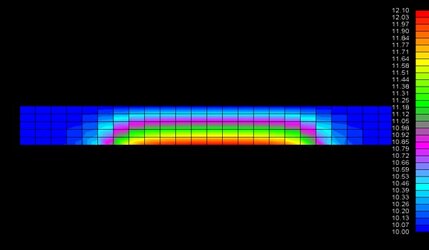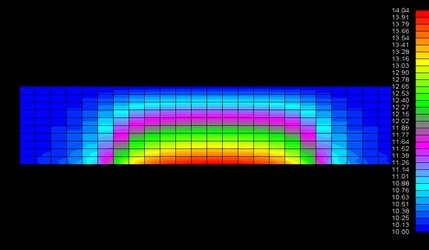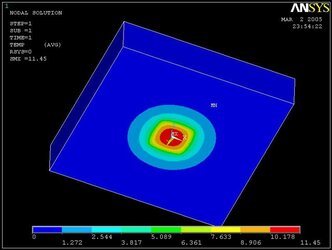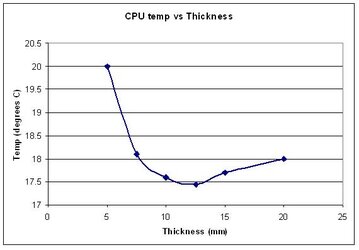Just because I can, I came up with a formula to sort of calculate the optimum thickness of a cold plate. As we know, the heat flow towards the
edges of the coldplate increases per unit temperaure with thickness while
the heat flow straight up decreases.
For simplicity, I am modeling the heat flux as a perfectly radial system.
Symbols used:
r1 = the radius of the cpu
r2 = the radius of the coldplate
r3 = reletive radius (r/r2) wich has a maximum value of 1 and a minimum
of 0
th = the thickness of the coldplate.
The sum of the thermal resistance can be simplified to the sum of the
thermal resistance in the radial direction and the thermal resistance in
the vertical direction.
The equation for thermal resistance of a section of thick walled pipe is
ln(r2/r1)/(2pi*th*k). This only acounts for constant heat flux. This
equation must be modefied to allow for heat loss off the faces. The
vetical heat loss as a function of radius is exponential due the fact
that the surface is two dimentional. The remaining heat is therefore
1-r3 squared. Since the heat flux is equal to a constant times the
temperature gradiant, the temperature gradiant is also (1-r^2) times the
tempurature gradiant of a the thick walled section of pipe. Integrating
from 0 to 1 to find the relative thermal resistance leaves us with a
value of exactly 1/4. Therefore the equation for a radial plate losing
heat off its face is ln(r2/r1)/(8pi*th*k).
We are not done yet. The heat flux towards the outside does not follow a
linear path. The path initially is a vertical up from the cpu, bends
horizontal, then bend vertical again. The actaul distance is therfore
not r2 but r2 + th*pi/2. This leaves us with
ln((r2+th*pi/2)/r1)/(8pi*th*k).
The eqation of the verticle heat transfer directly from the cpu straight
up to the tec is much simpler. It is th/(k*r1^2).
To find the total resistance of we combine the two equations, but it is
not as simple as adding them together. We need to take into acount the
relative amounts of heat traveling in the radial and verticle direction.
This amount is proportional to the the surface area of the TEC and the
surface area of the CPU die. The relative radial heat flux is
(r2^2-r1^20)/r2^2. The reletive vertical heat flux is r1^2/r2^2
Our fisrt equation would then be (r2^2-r1^20)/r2^2 *
ln((r2+th*pi/2)/r1)/(8pi*th*k). Our second equation is r1^2/r2^2 *
th/(k*r1^2), which simplifies to th/(r2^2*k).
Our final equation is (r2^2-r1^20)/r2^2 * ln((r2+th*pi/2)/r1)/(8pi*th*k)
+ th/(r2^2*k).
For those of you who do not want to compute this by hand the number of
times it would take to find the optimum value of th, fear not. I have
made this Excel function.
=LN((C1+1.57*A1)/B1)/(8*3.14159*A1*10)*(C1^2-B1^2)/C1^2+A1/C1^2/10
Just copy and paste it into Excel, put your guess for the optimum
thickness into cell a1, CPU die radius into b1, and your tec radius into
c1. If you know how, there is a solver tool that will find the value of
cell a1 that produces the smallest value of your function. Units are in
inches.
An added bennefit is that you can now find the thermal resistance of your
coldplate.
For a quick example, a coldplate (r2 = .98) on my 3.2e (r1 = .2) the
optimum thickness is .245inches and I get a thermal resistance of
.055C/W.
A final word of caution, we are simplifiying the system into a radial
system, which in reallity is square. I guestimate the error to be at the
very worst to be 5%. Also, this does not acount for the IHS. If you have
one, I would suggest you add maybe half the thickness of the IHS into the thickness of the coldplate to compensate.
Hope this helps you all.
edges of the coldplate increases per unit temperaure with thickness while
the heat flow straight up decreases.
For simplicity, I am modeling the heat flux as a perfectly radial system.
Symbols used:
r1 = the radius of the cpu
r2 = the radius of the coldplate
r3 = reletive radius (r/r2) wich has a maximum value of 1 and a minimum
of 0
th = the thickness of the coldplate.
The sum of the thermal resistance can be simplified to the sum of the
thermal resistance in the radial direction and the thermal resistance in
the vertical direction.
The equation for thermal resistance of a section of thick walled pipe is
ln(r2/r1)/(2pi*th*k). This only acounts for constant heat flux. This
equation must be modefied to allow for heat loss off the faces. The
vetical heat loss as a function of radius is exponential due the fact
that the surface is two dimentional. The remaining heat is therefore
1-r3 squared. Since the heat flux is equal to a constant times the
temperature gradiant, the temperature gradiant is also (1-r^2) times the
tempurature gradiant of a the thick walled section of pipe. Integrating
from 0 to 1 to find the relative thermal resistance leaves us with a
value of exactly 1/4. Therefore the equation for a radial plate losing
heat off its face is ln(r2/r1)/(8pi*th*k).
We are not done yet. The heat flux towards the outside does not follow a
linear path. The path initially is a vertical up from the cpu, bends
horizontal, then bend vertical again. The actaul distance is therfore
not r2 but r2 + th*pi/2. This leaves us with
ln((r2+th*pi/2)/r1)/(8pi*th*k).
The eqation of the verticle heat transfer directly from the cpu straight
up to the tec is much simpler. It is th/(k*r1^2).
To find the total resistance of we combine the two equations, but it is
not as simple as adding them together. We need to take into acount the
relative amounts of heat traveling in the radial and verticle direction.
This amount is proportional to the the surface area of the TEC and the
surface area of the CPU die. The relative radial heat flux is
(r2^2-r1^20)/r2^2. The reletive vertical heat flux is r1^2/r2^2
Our fisrt equation would then be (r2^2-r1^20)/r2^2 *
ln((r2+th*pi/2)/r1)/(8pi*th*k). Our second equation is r1^2/r2^2 *
th/(k*r1^2), which simplifies to th/(r2^2*k).
Our final equation is (r2^2-r1^20)/r2^2 * ln((r2+th*pi/2)/r1)/(8pi*th*k)
+ th/(r2^2*k).
For those of you who do not want to compute this by hand the number of
times it would take to find the optimum value of th, fear not. I have
made this Excel function.
=LN((C1+1.57*A1)/B1)/(8*3.14159*A1*10)*(C1^2-B1^2)/C1^2+A1/C1^2/10
Just copy and paste it into Excel, put your guess for the optimum
thickness into cell a1, CPU die radius into b1, and your tec radius into
c1. If you know how, there is a solver tool that will find the value of
cell a1 that produces the smallest value of your function. Units are in
inches.
An added bennefit is that you can now find the thermal resistance of your
coldplate.
For a quick example, a coldplate (r2 = .98) on my 3.2e (r1 = .2) the
optimum thickness is .245inches and I get a thermal resistance of
.055C/W.
A final word of caution, we are simplifiying the system into a radial
system, which in reallity is square. I guestimate the error to be at the
very worst to be 5%. Also, this does not acount for the IHS. If you have
one, I would suggest you add maybe half the thickness of the IHS into the thickness of the coldplate to compensate.
Hope this helps you all.




